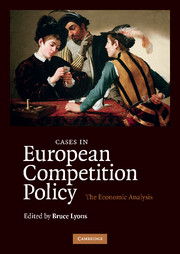Book contents
- Frontmatter
- Contents
- Contents by potentially anticompetitive business practices
- Contents by markets
- List of figures
- List of tables
- List of contributors
- Preface
- Introduction: the transformation of competition policy in Europe
- A Anticompetitive behaviour by firms with market power
- B Agreements between firms
- C Mergers
- Introduction
- C.1 Measurement of unilateral effects
- C.2 Coordinated effects
- 14 The ups and downs of the doctrine of collective dominance: using game theory for merger policy
- 15 Capacity constraints and irreversible investments: defending against collective dominance in UPM Kymmene/Norske Skog/Haindl
- C.3 Vertical and conglomerate effects
- Bibliography
- Index
15 - Capacity constraints and irreversible investments: defending against collective dominance in UPM Kymmene/Norske Skog/Haindl
Published online by Cambridge University Press: 05 June 2012
- Frontmatter
- Contents
- Contents by potentially anticompetitive business practices
- Contents by markets
- List of figures
- List of tables
- List of contributors
- Preface
- Introduction: the transformation of competition policy in Europe
- A Anticompetitive behaviour by firms with market power
- B Agreements between firms
- C Mergers
- Introduction
- C.1 Measurement of unilateral effects
- C.2 Coordinated effects
- 14 The ups and downs of the doctrine of collective dominance: using game theory for merger policy
- 15 Capacity constraints and irreversible investments: defending against collective dominance in UPM Kymmene/Norske Skog/Haindl
- C.3 Vertical and conglomerate effects
- Bibliography
- Index
Summary
Introduction
Scrutiny of potential mergers by the European Commission typically focuses on unilateral effects or single-firm dominance. But in a series of important cases starting with Kali and Salz, Nestlé-Perrier and most importantly Airtours, the Commission has showed itself concerned over the issue of ‘joint dominance’. However, until the judgment on Airtours there had been controversial debate whether ‘joint dominance’ was equivalent to the idea of coordinated effects as used in the US: the concern that the merger could increase the likelihood of consumer harm by making tacit collusion easier. But although the Court effectively established that a joint dominance finding required a ‘coordinated effects’ analysis, the practical implementation of such an approach has remained difficult. A particular challenge is how to bring empirical evidence to bear on finding or rejecting the existence of coordinated effects of a merger.
In this chapter we examine a case in newsprint and magazine paper – UPM Kymmene/Norske Skog/Haindl. The case involves two separate transactions in which Haindl sold all of its business to UPM Kymmene and the latter sold some of Haindl's major assets on to Norske Skog. The case arose because the Haindl family, which had run the business, wanted to withdraw from management activities. Haindl was an attractive target for UPM Kymmene because of its modern plant and low production costs. However, an outright takeover was likely to cause serious competition concerns, especially in magazine paper.
- Type
- Chapter
- Information
- Cases in European Competition PolicyThe Economic Analysis, pp. 383 - 410Publisher: Cambridge University PressPrint publication year: 2009
- 1
- Cited by



